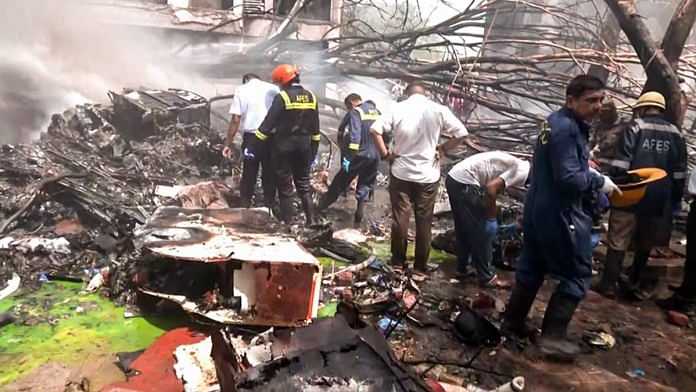Aviation accidents are exceedingly rare. The probability of an air accident is roughly 1 in 11 million flights. According to the International Civil Aviation Organization (ICAO)’s , 2023 was the safest year in the last five, with a global accident rate of 1.87 per million departures—down from 2.05 in 2022—and a fatality rate of 17 per billion passengers, down from 50 the year before. Global passenger traffic reached 4.2 billion in 2023, with over 35 million departures. Only one fatal accident occurred, involving a turboprop aircraft that claimed 72 lives. The International Air Transport Association (IATA)’s confirms this trend, recording 12 accidents, no jet hull losses, and no fatal jet crashes.
Yet, when crashes do occur, they are often catastrophic. ICAO data shows that about 80 per cent of accidents involve human factors, 15 per cent stem from technical issues, and 5 per cent are due to environmental conditions such as weather or bird strikes. In many cases, more than one factor is involved, highlighting the complex nature of aviation safety.
Human error dominates because aviation remains heavily dependent on human decision-making, especially during critical phases of flight such as take-off and landing. Technical failures, like engine malfunctions or system glitches, are less common, and even when they occur, aircraft redundancies prevent disaster. Environmental factors, such as low visibility, wet runways, turbulence, or bird strikes, can exacerbate existing problems, but rarely cause accidents on their own.
Human error encompasses a range of issues, from miscommunication to flawed decision-making under pressure. The ICAO defines “human factors” as the study of human abilities, limitations, and interactions with equipment, procedures, and environments.
In the case of AI171, experts have raised concerns over why the landing gear was not retraced by the crew immediately after take-off, as the standard procedure requires. The reason could be technical—such as a loss of hydraulic power caused due to loss of engine thrust, or an electrical malfunction. Or it could be a temporary lapse in decision-making ability under stress. Such errors are rare, but not improbable. The investigation would probe all possibilities.
Two factors often overlooked, but crucial to human performance, are training and fatigue.
Pilot training is the cornerstone of aviation safety, but gaps exist. The 1989 British Midland crash near Kegworth, England, which killed 47 people, was partly attributed to pilots’ unfamiliarity with a new aircraft variant. Similarly, the 2018 and 2019 Boeing 737 MAX crashes (346 deaths) exposed deficiencies in training on the MCAS automated system.
Modern training emphasises simulation, crew resource management (CRM), and handling automation. Still, the ‘startle effect’ triggered by unexpected real-world contingencies can overwhelm even the most experienced pilots. The only antidote is realistic and repeated training for time-critical emergencies. Experience alone offers no protection against failure.

Crew fatigue is another critical factor. Long-haul flights, irregular schedules, and tight turnarounds can impair cognitive function, slow reflexes, and cloud judgement. Studies estimate that fatigue contributes to 20 per cent of aviation incidents.
In the 2009 Colgan Air Flight 3407 crash (50 deaths), fatigued pilots failed to respond to a stall warning. While aviation regulators like the and impose duty-hour limits, enforcement varies. In 2024, DGCA proposed new Flight Duty Time Limitation (FDTL) norms to align with global practices. However, , implementation was postponed indefinitely.
Pilot unions approached the Delhi High Court, which directed the DGCA to enforce the revised norms. These updated rules, which offer slightly better working conditions, are yet to be implemented.
Technology has transformed aviation safety. Modern aircraft are built with multiple redundancies and are designed to operate safely even if key systems, like an engine, fail. Fly-by-wire controls and modern autopilot systems allow for more precise and safer flight operations. Digital cockpit displays offer real-time system-diagnostics, besides navigation and communication information.
Key safety innovations include:
: Alerts pilots to nearby traffic, preventing mid-air collisions.
: Warns pilots of terrain risks to reduce controlled flight into terrain (CFIT) accidents.
: Store critical data to support accident/incident investigations and improve standard operating procedures.
: Helps pilots avoid turbulence and storms.
Despite these advances, technology isn’t infallible. The AI171 crash occurred just 35 seconds after take-off, suggesting that under specific conditions, even advanced systems can fail so fast that recovery becomes impossible.
Could unmanned aircraft, like military drones or future autonomous passenger jets, eliminate human error? In theory, yes. AI-powered autonomous systems don’t suffer from fatigue, distraction, or stress. They don’t need sleep or frequent training, and regulatory compliance can be built into the code. Cargo drones tested by companies like UPS and Amazon have shown promising reliability in controlled environments.
But transitioning this technology to passenger aviation is a massive leap. Human pilots are still unmatched in their ability to improvise during unanticipated emergencies—as demonstrated by Captain Sully’s (Chesley Sullenberger) miraculous Hudson River landing, which saved 155 lives. AI struggles with unpredictable scenarios such as rare mechanical failures or complex air traffic control (ATC) instructions.
Public trust is another barrier. Passengers may hesitate to board pilotless planes. Imagine hearing: “I am your captain speaking. I am working from home today.”
Cybersecurity risks, such as hacking or failure of communication with ground stations, also merit consideration. Although unmanned military drones have lower crash rates than manned fighter jets (US Air Force data shows Predator drones crash at 7.5 per 100,000 hours vs 15 for F-16s), passenger aviation demands near-zero failure rates. For now, hybrid systems—where human pilots oversee AI-assisted operations—appear to offer the most plausible middle ground.
Flying remains extraordinarily safe. The crash of AI171, while devastating, is an outlier in an industry that has steadily reduced accident rates over decades. From the Wright brothers’ fragile biplane to today’s high-tech cockpits, aviation has evolved by learning from past tragedies.
Technology has bolstered safety. Regulations have grown stronger. Training has become more rigorous. But the AI171 crash exposes persistent vulnerabilities. Human factors, including fatigue and training gaps, demand stricter oversight.
India, now the world’s third-largest domestic aviation market, must match growth with safety. The DGCA must institute and enforce crew rest standards reflective of the high stress environment they operate in. Similarly, maintenance protocols must be followed rigorously. Tendency to continue operating aircraft with prolonged unserviceabilities under minimum equipment list must be curbed. Airlines must foster a culture where crew can report safety concerns without fear.
Unmanned flights may one day reduce human error, but for now, the focus should be on refining human-machine collaboration. The survival of Ramesh Vishwaskumar in AI171, against astronomical odds, reminds us of aviation’s resilience, as well as its fragility.
Flying remains safe. But to keep it that way, we must never stop improving.
(Edited by Prashant)








